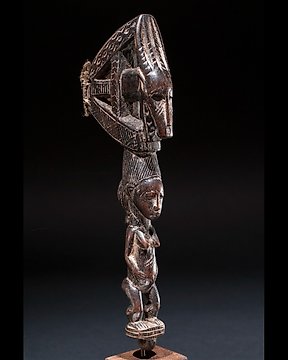
Gonghammer - Baule - Elfenbeinküste
Nr. 84050509

Nr. 84050509

A Baule portrait mask, Ivory Coast, of slender oval shape, a small half opened mouth, long thin nose, two arched eyebrows, underneath the large globulous eyes, a large and flat forehead, the hair is pulled up in a braided conical way, there are keloid marks on the forehead and near the eyes and cheeks. The shape of the face is of delicate design, the rims of the mask are punctured with attachment holes, under the jaw line are a frieze of triangles; the face is glossy by use, insect damage on the jaw, rims and hair of the mask, signs of use. Certificate of provenance.
“To articulate historians, the most consistent features of Baule art is a kind of peaceful containment. Faces tend to have downcast eyes and figures most often hold their ams against the body. […] Among their abundant art forms, the Baule people continue to place the greatest value on masks and figure sculptures, which remain the only sculptural art still widely used in Baule villages. While there is a difference between the Baule view of their objects and that of Western connoisseurs, there are points of agreement. Aesthetic appreciation is one: Baule artist, and individual owners of objects, certainly sometimes enjoy the beauty of these objects and the skill it took coproduce them. […]
Ornaments above the face are chosen for their beauty and have no iconographic significance” p.141
Lit: Baule: African Art, Western Eyes. Susan M.Vogel 1997
"The 400,000 Baule who live in central Côte d'Ivoire in West Africa have a rich carving tradition. Many sculpted figures and masks of human form are utilized in personal shrines and in masquerade performances. This mask was part of a secular masquerade in the village of Kami in the early 1900s. The Baule recognize two types of entertainment masks, Goli and Mblo..
To the Baule, sculpture serves many functions and these can shift over time and within different contexts. The Gbagba masquerade is a form of entertainment no longer practiced in Kami since the 1980s, replaced today by newer masks and performance styles. What is known, however, is that masks like this one were not intended to be hung on a wall and appreciated, first and foremost, for their physical characteristics. Sculpture throughout West Africa has the power to act; to make things happen. The physical presence of a mask can allow the invisible world to interact with and influence the visible world of humans. Scholar Susan Vogel mentions that Gbagba could bring social relief at the end of a long day and respite from everyday chores. It allowed residents to socialize, mourn, celebrate, feast, and even, court."
Source: Excerpt by Dr. Peri Klemm
Further resources:
Bernard Dadié and Melvin Dixon, “The Baoulé Legend,” Callaloo, no. 7 (1979): pp. 6–7.
Ravenhill, P. “Likeness and Nearness: The Intentionality of the Head in Baule “Art,“ African Arts, 33(2), 2002.
Susan M. Vogel, Baule: African Art, Western Eyes, New Haven, 1997.
Susan M. Vogel, "Known Artists but Anonymous Works: Fieldwork and Art History", African Arts, Vol. 31(1), 1999.
So kaufen Sie auf Catawiki
1. Etwas Besonderes entdecken
2. Höchstgebot abgeben
3. Sichere Zahlung durchführen